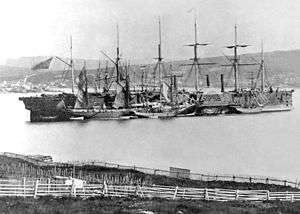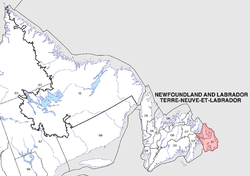Heart's Content, Newfoundland and Labrador
Heart's Content is an incorporated town in Trinity Bay on the Bay de Verde Peninsula of Newfoundland and Labrador, Canada.
Heart's Content | |
|---|---|
Town | |
 Heart's Content Location of Heart's Content in Newfoundland | |
| Coordinates: 47°52′13″N 53°21′52″W | |
| Country | |
| Province | |
| Settled | 1677 |
| Government | |
| • Mayor | Fred Cumby |
| Area | |
| • Total | 62.81 km2 (24.25 sq mi) |
| Population (2016) | |
| • Total | 340 |
| Time zone | UTC−03:30 (Newfoundland Time) |
| • Summer (DST) | UTC−02:30 (Newfoundland Daylight) |
| Area code(s) | 709 |
| Highways | |
 | |

| |
| Location | Heart's Content Bay de Verde Peninsula Newfoundland Canada |
|---|---|
| Coordinates | 45°52′56.5″N 53°23′07.0″W |
| Year first constructed | 1901 |
| Foundation | concrete base |
| Construction | cast iron tower |
| Tower shape | cylindrical tower with balcony and lantern |
| Markings / pattern | white and red spiral painted tower, white lantern roof |
| Tower height | 8.8 metres (29 ft) |
| Focal height | 25.5 metres (84 ft) |
| Range | 8 nautical miles (15 km; 9.2 mi) |
| Characteristic | Oc. W 6s. |
| Admiralty number | H0510 |
| CHS number | CCG 468 |
| NGA number | 1716 |
| ARLHS number | CAN-543 |
| Managing agent | Canadian Coast Guard[1][2] |
Geography
The natural harbour that makes up the town is located on the east side of Trinity Bay and it is built along the northeast side and the southeast base of this harbour. It opens out to Trinity Bay in a generally southwestern direction and protected from the harsh northern and eastern winds of the North Atlantic. Heart's Content is also at the crossroads of the main highway for Trinity Bay on the western side of the Bay de Verde peninsula and the highway cutting across the Bay de Verde peninsula between Victoria on the Conception Bay side and Heart's Content. The climate of the Atlantic Ocean and adjacent land areas is influenced by the temperatures of the surface waters and water currents as well as the winds blowing across the waters. Because of the oceans' great capacity for retaining heat, the climate of Heart's Content are moderate and free of extreme seasonal variations.
Precipitation falls on the area both as snow in the wintertime and moderate rainfall in summer.
The Gulf Stream and Labrador Current converge just off the coast of Newfoundland and provide for very dense fog that can linger in the area for days.
History
The first references to Heart's Content came from John Guy's journal of his voyage into Trinity Bay in 1612. Through much of the 17th century, Heart's Content was used by migratory fisherman from England. The area was permanently settled by at least 1677.
Like many other Newfoundland English settlements, this small village was a victim to the French army of Pierre Le Moyne d'Iberville in 1697. During King William's War, this village was raided in the Avalon Peninsula Campaign. In 1697, the French under d'Iberville entered Heart's Content. The final 30 men plus women and children retired to a fort commanded by Irishmen. The occupants surrendered to the French.
A 1700 Census records a population of 35, 5 fishing-stages and 7 boats.During the 18th century, the inshore cod fishery was the main source of income. Agriculture in the summer and logging in the winter also helped the fisherman and their families. In 1783, a docking facility was established to build sailing craft of all types. This was the first attempt to diversify the economy of Heart's Content. At its height, the industry employed 100 men, shipwrights, sail-makers, caulkers, woodsmen, sailors and blacksmiths.
Besides the growing importance of the Labrador fishery and the seal hunt, as well as the shipbuilding industry, other economic stimuli made it a growing and prosperous community. Transportation connections between Heart's Content and the rest of the Avalon Peninsula improved and greatly accommodated the movement of people and goods, and the overall production of business improved the town and other areas of Trinity and Conception Bays.
Within 10 years of incorporation Heart's Content obtained most of the facilities and the amenities of a small town. These included a town hall, fire station, a municipal park, water and sewage system, a ballpark and a senior citizens club.
19th century


- 1823 – Society for the Propagation of the Gospel opens its first school in Heart's Content, with Thomas Parker as teacher.
- 1862 – Rev. George Gardner founds the Fisherman's Society at Heart's Content, later the Society of United Fishermen.
- 1873 – Fisherman's Society organized in 1862 becomes the Society of United Fisherman with Rev. George Gardner as its first Grand Master.
- 1870s – The Methodist congregation is organized, they also built a school.
- 1880s – Population grows to an estimated 1,200 residents.
20th century
- 1915 – Heart's Content is linked by railway with the Conception Bay branch of the Reid Newfoundland Railway system. The rail connection allows the Anglo Newfoundland Development Company to use Heart's Content as a winter port for shipments of newsprint from its mill at Grand Falls.
- 1920 – A hydroelectric power plant is constructed by the Public Service Electric Company.
- 1930s – The decline in the fishing industry puts a complete end to the shipbuilding and boat building, and the loss of the railway drastically reduces the economic base of the town.
- 1932 – The United Towns Electric Company purchases the hydroelectric power plant and it was incorporated into its system.
- 1935 – Anglo Newfoundland Development Company stops using the port.
- 1960 – The power plant is enlarged and re-built, and for a short time made part of the Avalon power grid.
- 1967 – Heart's Content is incorporated as a Local Improvement District.
Transatlantic Cable
Heart's Content was given its place in the history of international communications by Cyrus West Field who chose it as the terminus of his Transatlantic telegraph cable, leading to establishment of the Heart's Content Cable Station.
- 1855 – Heart's Content is chosen as the location for the first transatlantic submarine telegraph cable.
- 1858 (August 5) – The first ever transatlantic cable, connecting Valentia, Ireland, to a site at Bay Bulls Arm, directly across Trinity Bay from Heart's Content, is landed. Due to a malfunction, its operation was terminated on October 20, 1858.
- In July 1866, when the cable was brought ashore, it was described as "a sheltered nook, where ships may ride at anchor safe from the storms of the ocean…on the beach is a small village of sixty houses, most of them the dwelling of these hardy men who vex the northern sea with their fisheries…"
- 1866 (July 27) – A new transatlantic cable is landed at Heart's Content by the SS Great Eastern.
- 1873 and 1874 – Two more cables are laid to Valentia.
- 1880 and 1894 – Two more cables were laid to Valentia, making Heart's Content one of the most important cable stations in the world.
- 1918 – The brick cable station is enlarged to serve the "Anglo-American Telegraph Company and its successor, Western Union, until its closure in 1965.
- 1968 – The brick cable building closed in 1965 is bought by the Provincial Government as an historic site and soon after begins a restoration project to make the almost 100-year-old building a communications museum.
- 1974 – (July 27) – 108 years after the landing of the transatlantic cable in the New World, the restored communications museum officially opens.
Rendell Forge

The Rendell Forge is a small, one-room, one storey wooden blacksmith shop located in Heart's Content. The Rendell family had a long history of blacksmithing in the community. The first to arrive was blacksmith Charles Rendell, who moved to Heart's Content from Trinity, Trinity Bay, in the early 1800s to craft ironwork for vessels.[3] In 1864-65, four Rendells were listed as blacksmiths: Charles, G., James, and John.[4] The 1904 directory lists five: Giles, Tolson, Charles Sr, John, and John T.[5] Ted Rowe writes,
Descendants of Charles Rendell produced an unbroken line in the blacksmith trade in Heart’s Content for three generations. His four sons Charles, Giles, James and John all took up the trade. Son Charles was also Heart’s Content’s first constable, appointed in the 1830s, and was prominent in the Loyal Orange Association. Bela, son of Giles, operated this forge with his son Jim in the 1920s. When business fell off during the depression years Jim moved his family to Hants Harbour. In 1941 at the age of 60 Bela went to Scotland as a blacksmith with the Newfoundland Overseas Forestry Unit. He returned to Heart’s Content at the end of the war and continued with the forge in the 1950s, turning out grapnels, horseshoes and custom ironwork. Following his death his son Ray worked the operation on a part-time basis.[6]
James Rendell (son of Charles Sr) moved to East Boston, Massachusetts, where he worked as a blacksmith, machinist, and businessman, and where he married Rebecca Rendell (née Pugh) of King's Road, St. John's on December 10, 1892.[7] Some of the Rendell blacksmiths went to Gander to work on the building of the airport and town in the 1940s.[8]
Nearby Communities
Heart's Content and surrounding areas are dotted by small fishing communities that were established due the proximity of each community to the fishing grounds. Some of the communities within a 15-minute driving distance from Heart's Content are:
- Winterton
- Turks Cove
- New Perlican
- Heart's Desire
- Heart's Delight
- Islington
Demographics
According to the 2011 census:
- Population: 375
- Population change: −10.3%
According to the 2006 census:
- Population: 418 ; 495 (2001)
- Land area: 62.81 square kilometres (24.25 sq mi)
- Population change (2001–6): −15.6%
- Source: Statistics Canada 2006 Census.[9]
Tourist attractions
- Cable Station Historic Site
- Society of United Fishermen No.1
- Cable Staff House Registered Heritage Site
- Heart's Content Lighthouse
- Heart's Content Harbour Authority
References
- Southeastern Newfoundland The Lighthouse DirectoryUniversity of North Carolina at Chapel Hill. Retrieved 9 February 2017
- List of Lights, Pub. 110: Greenland, The East Coasts of North and South America (Excluding Continental U.S.A. Except the East Coast of Florida) and the West Indies (PDF). List of Lights. United States National Geospatial-Intelligence Agency. 2016.
- Simmons, Lillian (August 7, 2012). "Town has enough history to warrant a heritage district". The Compass. Retrieved July 27, 2020.
- "1864 - 65 Directory - Heart's Content". ngb.chebucto.org. Retrieved July 27, 2020.
- "HEART'S CONTENT". ngb.chebucto.org. Retrieved July 27, 2020.
- Rowe, Ted (July 27, 2020). "The Rendell Forge, Heart's Content". The ICH Blog: Intangible Cultural Heritage, Folklore, and Oral History. Retrieved July 27, 2020.
- Lance Corporal Arthur James Rendell (PDF). The Rooms. p. 7.
- "Obituary for Leslie James Rendell at Greens Funeral Home & Services". www.greensfuneralservices.ca. Retrieved July 27, 2020.
- "Heart's Content Community Profile". Statistics Canada. 12.statcan.ca. December 2, 2010. Retrieved August 5, 2011.
External links
| Wikimedia Commons has media related to Heart's Content. |
See also
- List of lighthouses in Canada
- List of cities and towns in Newfoundland and Labrador
